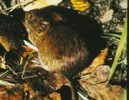
NPS Photo Subnivian refers to the space between the ground and the snow layer. Subnivian space can be particularly pronounced in areas with layers of vegetative debris. In winter, many of these smaller animals use the insulated subnivian space as shelter against the harsh surface conditions. They can also move about in tunnels under the snow out of the sight of predators. Therefore, adequate snow cover is crucial to the over-wintering success of many small mammals in Denali. One disadvantage of living in the subnivian world is the build up of carbon dioxide from respiration. When levels of carbon dioxide become high, small mammals will dig to the surface for fresh air. The most commonly encountered species of smaller mammals in Denali are the northern red-backed vole, the tundra vole, the singing vole, and the common shrew. Northern red-backed voles are one of the most abundant and wide spread small mammals in Denali and they are found in many different habitats. They eat many different types of food and often change diets among seasons. They eat the new growth of herbaceous plants during the summer, and then switch to seeds and berries in the autumn. Other food sources include bark, roots, lichens, fungi, and insects. They will stock pile food stores to use when it is difficult to forage. Tundra voles live in damp tundra vegetation near lakes and streams, or in sedge and cotton grass meadows. They feed on grasses, sedges, seeds, grain, bark, and insects. The singing vole has a high-pitched alarm call and lives in colonies with extensive underground tunnels. Singing voles gather huge amounts of vegetation and tubers and store them in underground burrows to use during the winter. Common shrews (or cinereus shrews) are tiny insectivores (shrews are among the smallest mammals on Earth). Shrews are always hungry. They have a very high metabolic rate and they often eat an equivalent to their body weight in food each day. They feed almost exclusively on insects throughout the year. During winter they feed on insect eggs, larvae, pupae, dormant adult insects, and dead animals. Common shrews are found in many different habitats and they live under the snow in the winter. They tend to have very short lives. Scientists from the University of Alaska Museum recorded the tiny shrew (Sorex yukonicus) in Denali in 2002. Discovered in Alaska in 1997, scientists are documenting this rare but widespread species throughout interior and northern Alaska. The abundance of small mammals in Denali fluctuates among years and regions. In some years there are very high numbers of voles and shrews, while other years these species are scarce. Scientists from the University of Alaska-Fairbanks are studying small mammals in Denali to describe the variation in population abundance and to determine the cause of these tremendous population fluctuations.
|
Last updated: January 28, 2025

